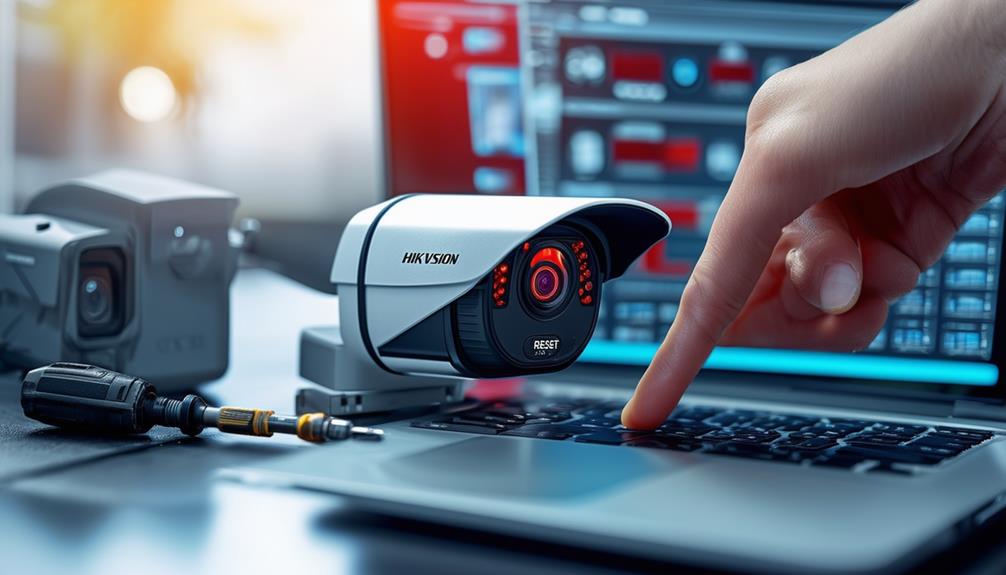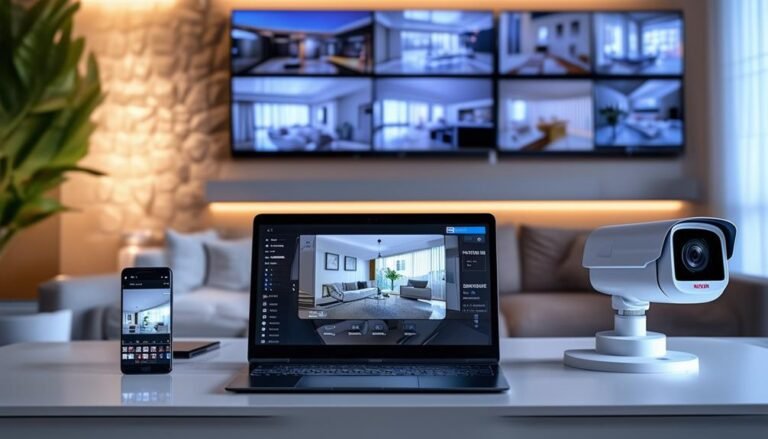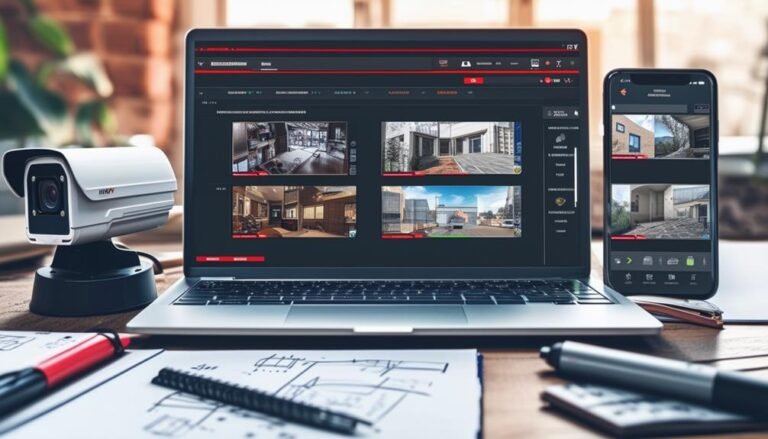To reset your Hikvision camera, you can either perform a soft or hard reset. For a soft reset, access your camera's web interface using its IP address, log in, and navigate to the "Maintenance" tab to find reset options. For a hard reset, locate the small reset button, usually needing a pin. Power on the camera, press and hold the button for 10 to 15 seconds, then release it. After resetting, log in with default credentials, and reconfigure your settings. If you face challenges, there are further tips and solutions available to help you get back on track.
Understanding the Reset Process
Resetting a Hikvision camera can seem intimidating, but understanding the reset process can simplify it. Knowing how to reset your camera not only gives you control but also empowers you to manage your security system effectively. A reset can help resolve issues, restore factory settings, or clear any glitches that may disrupt your camera's functionality.
To grasp the reset process, it's crucial to recognize that there are generally two types of resets: soft and hard resets. A soft reset often involves simply rebooting the device, which can be done through the camera's interface. This option is usually handy for minor issues. On the other hand, a hard reset involves returning the camera to its original factory settings. This method is more thorough and can be necessary if you're experiencing persistent problems or if you've forgotten your login credentials.
Before diving into the reset, familiarize yourself with the physical buttons on the camera. Many Hikvision models have a reset button that can be pressed and held for a specific duration to initiate the reset. Understanding this process allows you to act with confidence when faced with technical challenges.
Preparing for the Reset
Before you plunge into the reset process, it's essential to gather your tools and prepare your Hikvision camera for a smooth switch. You'll want to guarantee you have everything at your fingertips to avoid any unnecessary interruptions. Start by gathering your camera manual; it's your best friend during this process. Familiarizing yourself with the specifics of your model can save you time and frustration later on.
Next, check your power source. Make sure your camera is plugged in or has sufficient battery if it's a portable model. You don't want it shutting down right when you're in the middle of a reset. Additionally, have a stable internet connection ready if you plan to reconfigure settings afterward. This will help you get back online quickly and efficiently.
You should also consider backing up any important footage or settings. While a reset can be liberating, it often wipes out previous configurations. Taking a moment to save critical data will give you peace of mind.
Lastly, guarantee you're in a quiet, distraction-free environment. This process requires your full attention, and being focused will help you navigate through the steps more smoothly. Once you've gathered your materials and set the stage, you'll be ready to embrace the reset process with confidence and clarity. You're about to reclaim control over your camera, so let's make this changeover as seamless as possible!
Types of Resets
Understanding the types of resets available for your Hikvision camera can help you choose the right method for your needs. There are primarily two types of resets you might consider: a soft reset and a hard reset. Each serves a different purpose and can be useful depending on your situation.
A soft reset is often the go-to choice for minor issues. It's a quick way to reboot your camera without affecting any of your current settings. If you've noticed your camera acting sluggish or not responding properly, performing a soft reset can refresh the device and restore its functionality without losing your configurations. It's a simple process that can save you time and hassle.
On the other hand, a hard reset is a more drastic measure. This method restores your camera to its factory settings, wiping all configurations, including your username, password, and network settings. If you're facing significant issues, or if you've forgotten your password and can't access the device, a hard reset might be necessary. Keep in mind that after a hard reset, you'll need to set up everything from scratch.
Ultimately, knowing which type of reset to use will empower you to resolve issues effectively. You'll regain control over your surveillance system, allowing you to set it up just the way you want. Choose wisely, and you'll enjoy the freedom that comes with having your Hikvision camera operating flawlessly.
How to Reset via Web Interface
To reset your Hikvision camera via the web interface, you'll first need to access the device's settings through a web browser. Open your preferred browser and enter the camera's IP address in the address bar. You'll be prompted to log in, so use your admin credentials. Once logged in, you'll be greeted by the camera's main interface.
Next, navigate to the "Configuration" section in the menu. Look for the "Maintenance" tab, which often holds the reset options. This is where you can take control of your camera settings and make those necessary changes. Click on "Restore" or "Reset" to initiate the process. You'll be asked to confirm your choice, so take a moment to verify you really want to reset the camera, as this will erase all your customized settings.
After you confirm, the camera will begin the reset process. It may take a few moments, so don't rush it. You might see the camera reboot during this time; that's perfectly normal. Once the reset is complete, the camera will return to its factory settings.
Resetting Using the Reset Button
If you're looking for a straightforward way to reset your Hikvision camera, using the reset button is a quick and effective method. This approach is perfect for those who want to regain control and start fresh without maneuvering through complex menus or interfaces. To get started, locate the reset button on your camera. It's usually a small, recessed button that you'll need a pin or a paperclip to press.
Once you've found it, confirm that your camera is powered on. Press and hold the reset button for about 10 to 15 seconds. You might notice the camera's indicator lights blinking, which signals that the reset process is underway. Keep holding the button until you see the lights stabilize or change, indicating that the camera has been reset to its factory settings.
After releasing the button, give your camera a moment to reboot. This procedure effectively clears any previous configurations, allowing you to set it up as if it were new. It's a liberating feeling to wipe the slate clean and start anew, free from any past settings that may have caused issues.
Just remember, resetting your camera means you'll lose any custom settings you've previously configured, so be prepared to set it up again from scratch. But don't worry; this method is simple and will have you back in control of your camera in no time, ready to customize it to fit your needs perfectly.
Accessing the Camera After Reset
Regaining access to your Hikvision camera after a reset can feel like a fresh start, but it's essential to follow the right steps to guarantee a smooth reconnection. First, make sure your camera is powered on and connected to the network. You can use either an Ethernet cable or Wi-Fi, depending on your setup. If you're using Wi-Fi, verify that you've got the correct network credentials handy.
Next, open your web browser and enter the camera's default IP address. Typically, this is something like 192.0.0.64 for Hikvision devices. If you've changed it before the reset, you might need to use a network scanning tool to find out the new address. Once you've accessed the camera's interface, log in using the default credentials—usually "admin" for the username and "12345" or "admin" for the password, unless you've set a custom password.
After logging in, it's wise to change the password to something unique for security reasons. You'll also want to reconfigure other settings, like time zone, resolution, and recording options, to suit your needs. Don't forget to save your changes!
Troubleshooting Common Issues
Troubleshooting common issues with your Hikvision camera can be frustrating, but understanding the typical problems can help streamline the process. One common issue you might encounter is the camera not connecting to the network. First, check if the Ethernet cable is securely connected or if your Wi-Fi settings are correct. If it's a wireless connection, make sure the camera is within range of your router.
Another issue could be poor image quality. If your footage looks blurry or pixelated, it's worth checking the lens for dirt or obstructions. Cleaning it gently with a soft cloth can often resolve this problem. Additionally, verify that your camera's firmware is up to date, as outdated software can lead to performance issues.
If you're experiencing frequent disconnections, consider power supply issues. Make sure the power adapter is functioning correctly and that the camera is receiving adequate power. You can also try resetting the camera to default settings if the problems persist.
Lastly, if you can't access the camera's live feed, it might be due to incorrect login credentials. Double-check your username and password, as they're case-sensitive. If you still can't log in, a factory reset could be necessary.
Tips for Preventing Future Issues
Preventing future issues with your Hikvision camera can save you time and frustration down the line. By following a few simple tips, you'll guarantee that your system runs smoothly and efficiently. Here are some proactive measures you can take:
| Action | Frequency | Benefit |
|---|---|---|
| Regular Firmware Updates | Every 3-6 months | Enhances security and performance |
| Check Connections | Monthly | Prevents disconnections and image loss |
| Clean the Camera Lens | Every 1-2 months | Improves image clarity and quality |
Staying on top of firmware updates is essential. Manufacturers often release updates to fix bugs and enhance features. Don't let your camera fall behind. Additionally, make it a habit to check all connections, including power and internet, to avoid unexpected downtime. A little maintenance goes a long way.
Cleaning the camera lens is another important step. Dust and grime can obscure your view, diminishing the camera's effectiveness. Taking a moment to wipe it down can vastly improve image quality.
Lastly, consider using a surge protector. Power surges can cause significant damage to your camera, so safeguarding it can extend its lifespan. By incorporating these practices, you'll not only enhance your camera's performance but also enjoy peace of mind knowing that you're taking control of your security. Embrace these habits, and your Hikvision camera will serve you well for years to come!
When to Seek Professional Help
Knowing when to seek professional help for your Hikvision camera can save you from unnecessary headaches. If you've tried resetting your camera multiple times without success, it might be time to call in an expert. Sometimes, the issue goes beyond a simple reset; there could be deeper technical problems that require specialized knowledge.
Another scenario is when you notice physical damage to the camera. If your device has been knocked over or exposed to harsh weather, attempting repairs on your own can lead to further complications. Professionals have the right tools and experience to assess and fix hardware issues safely.
If you're struggling with network connectivity problems that you can't seem to resolve, don't hesitate to reach out for help. These issues might involve settings or configurations that are tricky to navigate without a solid background in network management. A professional can guarantee your camera connects seamlessly to your network and functions as intended.
Lastly, if you're unsure about the warranty or service agreements, it's best to consult with a professional. They can guide you on the best course of action without jeopardizing your warranty status.
In the end, knowing when to ask for help can lead to quicker resolutions and a more secure surveillance experience. You deserve peace of mind knowing your Hikvision camera operates smoothly and effectively. Don't hesitate to seek out expertise when you need it.
Frequently Asked Questions
Can I Reset My Hikvision Camera Remotely?
Did you know that nearly 70% of people prefer managing their devices remotely? You'll love the freedom of controlling your Hikvision camera from anywhere. While you can't directly reset it remotely, you can access its settings through the app or web interface to adjust configurations. If you're facing issues, consider power cycling the camera or accessing it through your network for a soft reset. Embrace the convenience of modern technology!
Will Resetting Delete All My Camera Settings?
When you reset your camera, it typically restores all settings to factory defaults. This means you'll lose any custom configurations you've set up, like specific recording schedules or alert settings. If you value your current setup, consider backing up your settings if your device allows it before proceeding. It's all about maintaining your freedom to customize your surveillance experience. So, weigh your options carefully before hitting that reset button!
How Often Should I Reset My Hikvision Camera?
You wouldn't want to feel trapped by technology, right? Resetting your Hikvision camera isn't something you should do often. Ideally, you should only reset it if you're experiencing persistent issues or after significant updates. Frequent resets can lead to frustration, losing settings you've carefully configured for your security needs. Trust your instincts; if it's running smoothly, there's no need to reset. Enjoy that freedom of having a reliable surveillance system!
Are Firmware Updates Necessary After Resetting?
Yes, firmware updates are necessary after resetting your camera. They guarantee you're using the latest features and security patches, keeping your device running smoothly. If you skip updates, you might miss out on important improvements or fixes. It's a good practice to check for updates regularly, especially after a reset. This way, you'll maximize your camera's performance and maintain its reliability in safeguarding your space. Stay proactive for the best experience!
Can I Reset Multiple Cameras at Once?
You can't reset multiple cameras at once through a single command. Each camera needs to be reset individually. It might seem tedious, but it's essential for ensuring each unit is configured properly. Take your time with each one to avoid issues later. If you're managing a lot of cameras, consider documenting the process or creating a checklist to stay organized. Remember, a thorough reset can help maintain your system's efficiency and performance.



